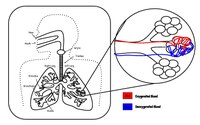
Photo from wikipedia
ABSTRACT Many marine organisms and life stages lack specialized respiratory structures, like gills, and rely instead on cutaneous respiration, which they facilitate by having thin integuments. This respiratory mode may… Click to show full abstract
ABSTRACT Many marine organisms and life stages lack specialized respiratory structures, like gills, and rely instead on cutaneous respiration, which they facilitate by having thin integuments. This respiratory mode may limit body size, especially if the integument also functions in support or locomotion. Pycnogonids, or sea spiders, are marine arthropods that lack gills and rely on cutaneous respiration but still grow to large sizes. Their cuticle contains pores, which may play a role in gas exchange. Here, we examined alternative paths of gas exchange in sea spiders: (1) oxygen diffuses across pores in the cuticle, a common mechanism in terrestrial eggshells, (2) oxygen diffuses directly across the cuticle, a common mechanism in small aquatic insects, or (3) oxygen diffuses across both pores and cuticle. We examined these possibilities by modeling diffusive oxygen fluxes across all pores in the body of sea spiders and asking whether those fluxes differed from measured metabolic rates. We estimated fluxes across pores using Fick's law parameterized with measurements of pore morphology and oxygen gradients. Modeled oxygen fluxes through pores closely matched oxygen consumption across a range of body sizes, which means the pores facilitate oxygen diffusion. Furthermore, pore volume scaled hypermetrically with body size, which helps larger species facilitate greater diffusive oxygen fluxes across their cuticle. This likely presents a functional trade-off between gas exchange and structural support, in which the cuticle must be thick enough to prevent buckling due to external forces but porous enough to allow sufficient gas exchange. Editors' choice: Sea spiders are a group of arthropods that lack gills but still grow to large sizes; cuticular pores facilitate oxygen diffusion in large species to meet their metabolic demands.
Journal Title: Journal of Experimental Biology
Year Published: 2018
Link to full text (if available)
Share on Social Media: Sign Up to like & get
recommendations!